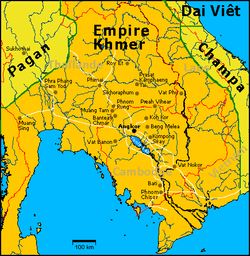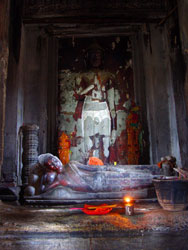 The Khmer Empire was one of the most powerful kingdoms in Southeast Asia, based in what is now Cambodia and flourishing from the 9th to the 13th century. The empire, which grew out of former kingdom of Chenla, at times ruled over and/or vassalized parts of modern-day Laos, Thailand, Vietnam, Myanmar, and Malaysia. Its greatest legacy is Angkor, the site of the capital city during the empire's zenith. Angkor bears testimony to the Khmer empire's immense power and wealth, as well as the variety of belief systems that it patronised over time. The empire's official religions included Hinduism and Mahayana Buddhism, until Theravada Buddhism prevailed, even among the lower classes, after its introduction from Sri Lanka in the 13th century. Modern researches by satellites have revealed Angkor to be the largest pre-industrial urban center in the world.
The Khmer Empire was one of the most powerful kingdoms in Southeast Asia, based in what is now Cambodia and flourishing from the 9th to the 13th century. The empire, which grew out of former kingdom of Chenla, at times ruled over and/or vassalized parts of modern-day Laos, Thailand, Vietnam, Myanmar, and Malaysia. Its greatest legacy is Angkor, the site of the capital city during the empire's zenith. Angkor bears testimony to the Khmer empire's immense power and wealth, as well as the variety of belief systems that it patronised over time. The empire's official religions included Hinduism and Mahayana Buddhism, until Theravada Buddhism prevailed, even among the lower classes, after its introduction from Sri Lanka in the 13th century. Modern researches by satellites have revealed Angkor to be the largest pre-industrial urban center in the world.From Kambuja itself - and so also from the Angkor region - no written records have survived other than stone inscriptions. Therefore the current knowledge of the historical Khmer civilization is derived primarily from:
- archaeological excavation, reconstruction and investigation
- stone inscriptions (most important are foundation steles of temples), which report on the political and religious deeds of the kings
- reliefs in a series of temple walls with depictions of military marches, life in the palace, market scenes and also the everyday lives of the population
- reports and chronicles of Chinese diplomats, traders and travellers.
The beginning of the era of the Khmer kingdom is conventionally dated to 802 AD. In this year, king Jayavarman II had himself declared chakravartin ("king of the world", or "king of kings") on Phnom Kulen.



0 comments:
Post a Comment